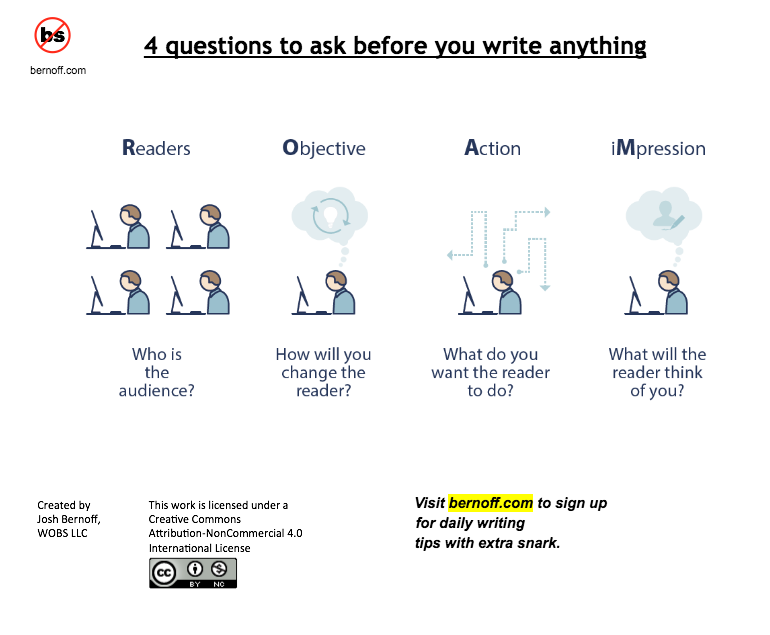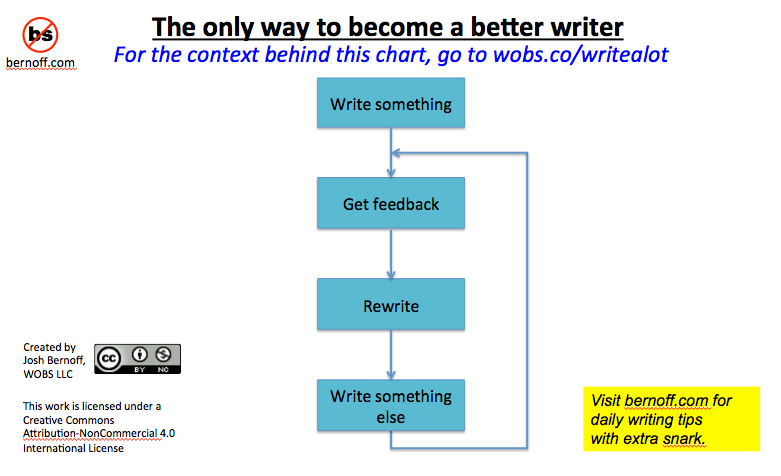
Social media demands a very different approach to writing. I’ve been a business writer for 35 years, a blogger for 10, and a social media analyst since 2008. I now blog every weekday. Everything I learned about writing in college—and since then, in the working world—is ill-suited to a world where everyone reads on a screen.
Your audience is reading all day long. (The business professionals I surveyed earlier this year spent an average of 46 hours per week on reading and writing.) They’re flooded with information. As a result, they spend only 36 seconds on the average news article, according to Chartbeat, which measures media attention. You need to write differently for distracted on-screen readers. Here’s how.
Plan Analytically
You shouldn’t write anything for public consumption unless you’ve got a clear idea of what you want that writing to accomplish. I recommend a four-step process that you can remember by the acronym ROAM.
- Readers: Define your target audience—for example, people who are seeking a coding job.
- Objective: Define how your writing will change the reader. For example, after reading what you wrote, the reader will know the best way to describe their qualifications in LinkedIn.
- Action: Determine what you want the reader to do. This is not the same as the objective. For example, if you were writing a blog post, you might want the reader to subscribe to your blog, or to share the post with others.
- iMpression: This is the part most people forget about. How will they think of you? Do you want them to believe you are helpful, or expert, or a good resource? Every piece of writing creates an impression; yours ought to work for you.

I recommend the ROAM analysis for any writing, but it’s particularly helpful for social media posts and content marketing. The Objective is typically to teach the reader something, and the Action is to get them to spread your message. Unless you’ve nailed all four elements down, you’ve got no business starting to write.
Get to the Point Quickly
If you’re writing a blog post, people will decide to read it or not based on the title and the first few sentences. Those two elements must describe what’s coming (and if you want to preserve your integrity, they should be accurate—clickbait doesn’t make a good impression). So I recommend a radically frontloaded style that gets right to the point, rather than easing into it. Here are the titles and openers of two of my most popular recent posts:
10 top writing tips and the psychology behind them (750K views)
There are plenty of folks happy to tell you how to write better, just as any doctor will tell you to “eat right and exercise.” But changing your writing (or eating) habits only happens when you understand why you do what you do. I can help you with that.
Apple’s Tim Cook shows how to communicate in a crisis (23K views)
Apple’s in a bind. The FBI wants them to crack the encryption on a San Bernardino terrorist’s iPhone. Apple believes that’s a dangerous precedent. Apple CEO Tim Cook’s open letter is breathtakingly simple and clear. Learn from it.
I haven’t said anything yet about SEO. That’s because SEO should be an afterthought. Great content not only gets traffic but also makes an impression; content choked with keywords doesn’t. Change a few words if you want to entice Google, but don’t do it at the expense of helpful content. And remember that the title and opening sentences are also what people will read in any Google snippets.
The same front-loading rules apply even more to posts in Facebook or Twitter. You’ve got to get right to the point.
Here’s a tip: Most people take a while to get going when they write. That’s fine. Just go back and delete those warmup paragraphs before you turn in or publish your draft. Start right in with the meaty stuff.
[contextly_auto_sidebar]
Be Skimmable
Paragraphs suck. Stack them up, and they’re about as inviting as wall of stacked cinderblocks. If you want to invite people to read, you’re going to have to make the structure of what you’re writing easily visible and accessible. So replace that stack of paragraphs with:
- Headings: Break your posts up. Even community and Facebook posts can benefit from headings—just use a heading in capital letters if the platform doesn’t support bold headings.
- Bullets: Lists (like this one) are a lot easier to swallow than paragraphs. Use numbered lists if there’s an obvious sequence.
- Graphics: Every post ought to have one, and preferably not just a gratuitous photograph. Even a crude diagram made in PowerPoint can help get the point across. For example, the simple graphic below about good writing habits was one of my most popular graphics. Graphics get you additional real estate on Facebook, Twitter, and Tumblr and can spread independently on sites like Pinterest and Instagram. Remember that graphics spread separately from other content, so make your URL and brand prominently visible.

- Tables: Tables have a high information density. If you’re working on a list, ask yourself if it’s regular enough to be rendered as a text table. Unfortunately, tables render in random ways depending on the browser and device you’re using, so it’s better to screenshot them and turn them into graphics for social media.
- Quotes and links: For social media writers, links become a sort of running commentary that allows them to be succinct but still reference other sources. Quoted, indented material breaks up the text. Both make you a better citizen of the social media world by referencing and pointing to other people’s work.
Since you read Jay Baer’s work, you know that you want to be a helpful and useful writer. With tips like these, you can be succinct, direct, and readable, too. And that’s as helpful and useful as you can get.
Get more content like this, plus the very BEST marketing education, totally free. Get our Definitive email newsletter.


